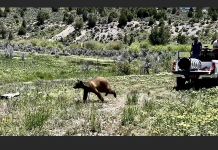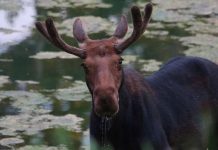SALT LAKE CITY, Utah, May 15, 2024 (Gephardt Daily) — Friday marks Endangered Species Day, and the Utah Department of Wildlife Resources is using it to highlight the comeback of the Utah prairie dogs, “one of Utah’s species listed under the Endangered Species Act that has made great strides in recovery in recent years,” the agency says.
Utah has three species of prairie dogs, but the Utah prairie dog is only found in the southwestern part of the state and nowhere else in the world, the DWR says.
They have a small range, especially compared with other prairie dog species. Utah prairie dogs have dark eyebrows and are the smallest species of prairie dog, the DWR information says. Utah prairie dogs share many traits with the closely-related Gunnison’s prairie dog and white-tailed prairie dog (the other two prairie dog species found in Utah). However, the ranges where each species is located do not overlap.
Utah prairie dogs are the only prairie dog species in the U.S. that are listed as endangered or threatened under the Endangered Species Act. The Utah prairie dog has been listed under the Endangered Species Act since 1973.
“Several things contributed to the decline of the species, but unregulated poisoning and plague were the primary threats,” said Barbara Sugarman, DWR Utah prairie dog recovery biologist.
“Extensive research, monitoring and conservation efforts by federal and state agencies, counties, and others have been in effect since 1973 to help the species recover.”
In addition to other conservation efforts, the Utah Division of Wildlife Resources conducts surveys each spring to estimate the population of Utah prairie dogs. Long-term data suggests that the range-wide population of the Utah prairie dog has been stable or increasing over the last three decades.
“Utah prairie dogs are doing extremely well right now,” Sugarman said. “During the spring counts last year, we counted just under 10,000 Utah prairie dogs, and met the recovery goal of more than 1,000 adult Utah prairie dogs counted on public and protected land in each of the three recovery units simultaneously. That is the first time that each recovery unit has met the recovery goal at the same time since counts began in 1976.”
As of last year, the estimated range-wide population for the species was 69,537 Utah prairie dogs. This year’s Utah prairie dog spring count is currently being conducted, but preliminary counts are even higher than last year, and the species is on track to potentially meet the recovery goal again.
“There are several factors that have contributed to the conservation success of Utah prairie dogs,” Sugarman said. “However, the biggest factor has been the ongoing coordination and cooperation between numerous partnering agencies and organizations, which has been the catalyst for the species rebounding. Other factors that have led to the species’ success include habitat treatments, preventative disease treatments and translocation efforts.”
Sadly, no formal gatherings are planned to celebrate Utah prairie dogs on Friday. But to party on your own, learn more about the work to conserve Utah prairie dogs on the DWR Wild podcast.
Utah species listed under the Endangered Species Act
There are currently 17 wildlife species in Utah on the federal endangered species list, with eight listed as endangered and nine listed as threatened. Fortunately, several of these species have made remarkable progress in recent years.
An endangered species is any species that is at serious risk of extinction in a specific area or throughout all of its natural habitat. A threatened species is any species that is likely to become an endangered species in the foreseeable future throughout much or all of its habitat. A species is classified as a species of greatest conservation need in the Utah Wildlife Action Plan if it is a threatened or endangered species, or a species that needs some level of conservation attention.
The U.S. Fish and Wildlife Service (a federal agency) has jurisdiction over species listed as threatened and endangered under the Endangered Species Act. The Utah Division of Wildlife Resources (a state agency) has jurisdiction over all other wildlife, and the Utah Wildlife Action Plan identifies other species in need of conservation attention and provides a plan to keep them from becoming listed under the Endangered Species Act.
Since 2001, the DWR and other partners have helped prevent 20 wildlife species from being listed as endangered and threatened through conservation efforts guided by the Utah Wildlife Action Plan.





